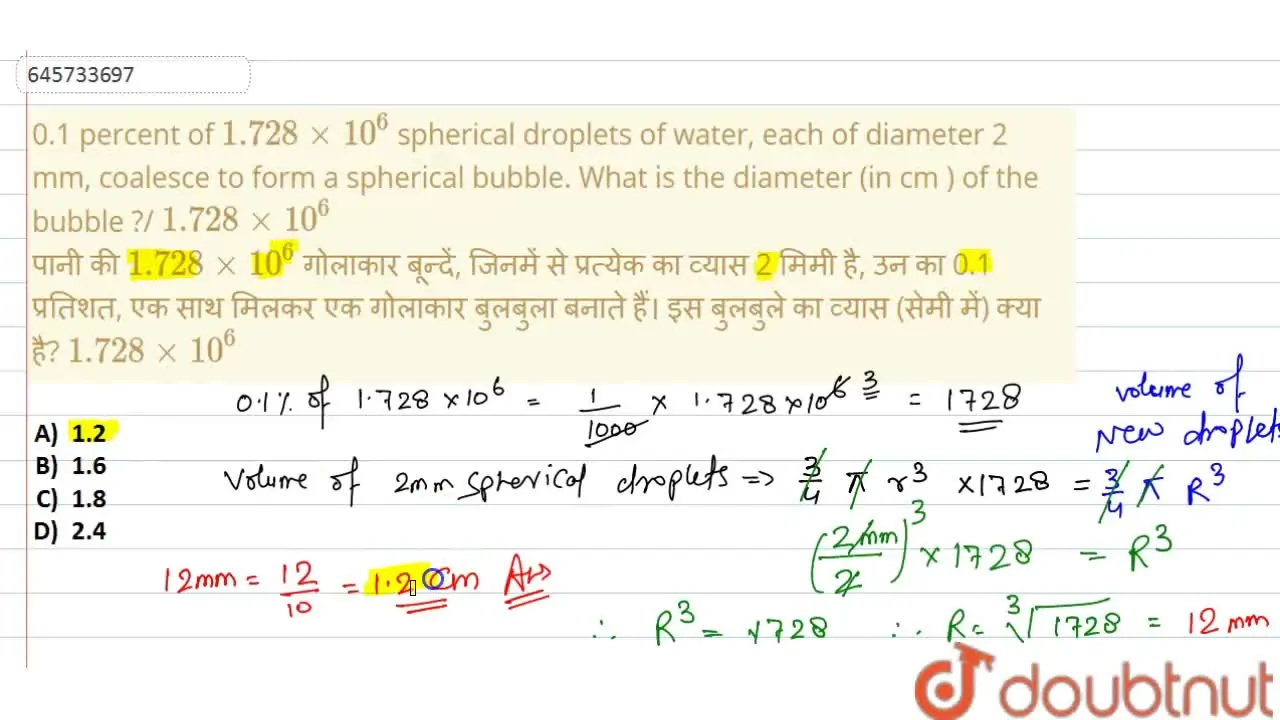0.1 percent of 1.728×106 spherical droplets of water, each of diameter 2 mm, coalesce to form a spherical bubble. What is the diameter (in cm ) of the bubble ?/ 1.728×106
पानी की 1.728×106 गोलाकार बून्दें, जिनमें से प्रत्येक का व्यास 2 मिमी है, उन का 0.1 प्रतिशत, एक साथ मिलकर एक गोलाकार बुलबुला बनाते हैं। इस बुलबुले का व्यास (सेमी में) क्या है? 1.728×106
1.2
1.6
1.8
2.4
Step by step video & image solution for 0.1 percent of 1.728 xx 10^6 spherical droplets of water, each of diameter 2 mm, coalesce to form a spherical bubble. What is the diameter (in cm ) of the bubble ?/ 1.728 xx 10^6 पानी की 1.728 xx 10^6 गोलाकार बून्दें, जिनमें से प्रत्येक का व्यास 2 मिमी है, उन का 0.1 प्रतिशत, एक साथ मिलकर एक गोलाकार बुलबुला बनाते हैं। इस बुलबुले का व्यास (सेमी में) क्या है? 1.728 xx 10^6 by Maths experts to help you in doubts & scoring excellent marks in Class 14 exams.
Related Playlists
Similar Questions
0.1 percent of 1.728×106 spherical droplets of water, each of diameter 2 mm, coalesce to form a spherical bubble. What is the diameter (in cm ) of the bubble ?/ 1.728×106
View SolutionWhat amount of energy will be liberted if 1000 droplets of water each of diameter 10−6 cm. coalesce to from a bigger drop. Surface tension of water is 75×10−3Nm−1
View Solution' व्यास ' का विलोम शब्द है -
View SolutionThe diameters of the internal and external surfaces of a hollow spherical shell are 6 cm and 10 cm respectively. If it is melted and made of solid cylinder of length 8/3 cm, then the diameter (in cm) of the cylinder is-
एक खोखले गोलाकार खोल की आंतरिक एवं बाहरी सतहों का व्यास क्रमशः 6 सेमी ओर 10 सेमी है। यदि इसे गलाकर 8/3 सेमी लंबाई का ठोस बेलन बनाया जाता है, तो बेलन का व्यास (सेमी में) कितना होगा?View SolutionThe spherical liquid bubble of diameter 4×10−3 m has inner and outer pressure as 1.005 and tension of the lquid of the liquid is
View SolutionA metallic solid spherical ball of radius 3 cm is melted and recast into three spherical balls. The radii of two of these balls are 2 cm and 1.5cm . What is the surface area (in cm2) of the third ball?
त्रिज्या 3 सेमी की एक ठोस गोलाकार गेंद को पिघलाया जाता है और तीन गोलाकार गेंदों में बदल दिया जाता है। इन गेंदों में से दो की त्रिज्या 2 सेमी और 1.5 सेमी है। तीसरी गेंद का सतह क्षेत्र (सेमी 2 में) क्या हैView SolutionThree spherical balls of radii 1 cm, 2cm and 3 cm are melted to form a single spherical ball. In the process, the loss of material is 25%.The radius of the new ball is-
अर्द्धव्यास 1 सेमी, 2 सेमी तथा 3 सेमी वाली तीन गोलाकार मेंदों को पिघलाकर एक अकेली गोलाकार गेंद बनाई जाती है। इस प्रक्रिया में 25% सामग्री बर्बाद हुई है। नई गेंद का अर्द्धव्यास होगा?View SolutionThe internal diameter of a hollow hemispherical vessel is 24 cm. It is made of a steel sheet which is 0.5 cm thick. What is the total surface area (in cm2) of the vessel ?
एक खोखले अर्धगोलीय बर्तन का आतंरिक व्यास 24 सेमी है | यह इस्पात की चादर से बना हुआ है जिसकी मोटाई 0.5 सेमी है | इस बर्तन का कुल पृष्ठ क्षेत्रफल ( वर्ग सेमी में) ज्ञात करें |View SolutionThe diameter of the base of a right circular cone is 10 cm and its height is 12 cm. What is the total surface area (in cm2) of the cone?
एक लम्ब वृत्तीय शंकु के आधार का व्यास 10 सेमी है तथा इसकी ऊंचाई 12 सेमी है | इस शंकु का कुल पृष्ठ क्षेत्रफल ( वर्ग सेमी में ) कितना है ?View SolutionThe height of a cylinder is 30 cm and the diameter of its base is 10 cm. Two identical conical holes each of radius 5 cm and height 12 cm are drilled out. what is the surface area(in cm2) of the remaining solid?
एक सिलेंडर की ऊंचाई 30 सेमी है और इसके आधार का व्यास 10 सेमी है। दो समान शंक्काकार हिद्र प्रत्येक त्रिज्या 5 सेमी और 12 सेमी तक ड्रिल कर बाहर निकाल दिया जाता है शेष ठोस का पृष्ठीय क्षेत्रफल क्या है?View Solution


